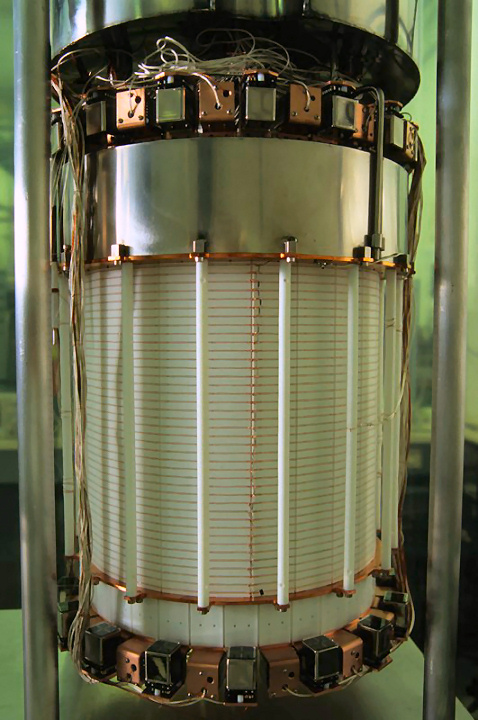XENON100 sets record limits for dark matter
Scientists from the XENON collaboration announced a new result from their search for dark matter. The analysis of data taken with the XENON100 detector during 13 months of operation at the Gran Sasso Laboratory (Italy) provided no evidence for the existence of Weakly Interacting Massive Particles (WIMPs), the leading dark matter candidates. Two events being observed are statistically consistent with one expected event from background radiation. Compared to their previous 2011 result the world-leading sensitivity has again been improved by a factor of 3.5. This constrains models of new physics with WIMP candidates even further and it helps to target future WIMP searches. A paper with the results is going to be submitted to Physical Review Letters and on the the arXiv.
Cosmological observations consistently point to a picture of our Universe where ordinary matter as we know it makes up only about 4%, while new, yet unobserved forms of so-called dark matter and dark energy make up the rest. This fits to expectations from subatomic physics where extensions of the Standard Model of particle physics suggest that new particles must exist, which have properties making them perfect dark matter candidates. Both cosmology and particle physics provide consistent hints on the existence of dark matter. A search for WIMP particles is therefore well motivated and a direct detection of such particles is the central missing piece of information to confirm this new picture of our Universe.
In 2011, the XENON100 collaboration published results from 100 days of data taking. The achieved sensitivity pushed the limits for WIMPs already by a factor 5 to 10 compared to the previous XENON10 results. During the new run a total of 225 live days of data were accumulated in 2011 and 2012 with lower background and hence improved sensitivity. Again no signal was found. The two observed events are statistically consistent with the expected background of one event. The new data improve the bounds to 2.0×10-45 cm2 for a WIMP mass of 50 GeV, which is another factor of 3.5, cutting already significantly into the expected WIMP parameter region. Continued measurements with XENON100 and the new experiment XENON1T, currently under construction, should either find evidence for WIMPs or other forms of dark matter would have to be considered.
XENON100 is an ultra-sensitive device using 62 kg of liquid, ultra-pure xenon as a WIMP target, and measures the tiny charge and light signals that are expected from rare collisions between WIMPs and the nuclei of xenon atoms. The detector is operated deep underground at the Gran Sasso National Laboratory of the INFN, in Italy, in order to shield it from cosmic rays which constantly bombard the Earth. To avoid false events due to residual radiation from the detector’s surroundings, only data from the inner 34 kg of liquid xenon are taken as candidate events. The detector is in addition shielded by specially designed layers of copper, polyethylene, lead and water, to reduce the background noise even further.
The XENON collaboration consists of scientists from 15 institutions in the USA (Columbia University New York, University of California Los Angeles, Rice University Houston, Purdue University), France (Subatech Nantes), Germany (Max-Planck-Institut für Kernphysik Heidelberg, Johannes Gutenberg University Mainz, Westfälische Wilhelms-Universität Münster), Israel (Weizmann Institute of Science), Italy (Istituto Nazionale di Fisica Nucleare, Università di Bologna), Netherlands (Nikhef Amsterdam), Portugal (Universidade de Coimbra), Switzerland (Universität Zürich), and China (Shanghai Jiao Tong University).
The Muenster group of Prof. Christian Weinheimer at Institut für Kernphysik has been involved in XENON100 with the detector operations and the purification of the Xenon target during the dark matter search as well as with data analysis in the characterization of the detector response. For this research the group is supported by Deutsche Forschungsgemeinschaft. The Münster group is also contributing to the next phase of the experiment, XENON1T, by researching, designing and building the purification system and cryogenic distillation system of the liquid XENON necessary for a detector with an increased sensitivity by a factor of 100. For XENON1T the group is funded by the German Ministery for Education and Research BMBF.
XENON100 is supported by the collaborating institutions and by the National Science Foundation and the Department of Energy in the USA, by the Swiss National Foundation in Switzerland, by l'Institut National de Physique des Particules et de Physique Nucléaire and La Région des Pays de la Loire in France, by the Max Planck Society and by Deutsche Forschungsgemeinschaft in Germany, by the Weizmann Institute of Science, by the German-Israeli Minerva Gesellschaft and GIF in Israel, by FOM in the Netherlands, by the Fundação para a Ciência e Tecnologia in Portugal, by the Istituto Nazionale di Fisica Nucleare in Italy and by STCSM in China.
Further information:
Collaboration webpages: http://xenon.astro.columbia.edu/
Contact:
Max-Planck-Institut für Kernphysik:
Prof. Dr. Manfred Lindner
Tel.: +49 6221 516 800
E-Mail: manfred.lindner (at) mpi-hd.mpg.de
Universität Mainz:
Prof. Dr. Uwe Oberlack
Tel.: +49 6131 3925167
E-Mail: oberlack@uni-mainz.de
Universität Münster:
Prof. Dr. Christian Weinheimer
Tel.: +49 251 83 34971
E-Mail: weinheimer@uni-muenster.de
Universität Zürich:
Prof. Dr. Laura Baudis
Tel.: +41 44 635 5777
E-Mail: lbaudis@physik.uzh.ch

